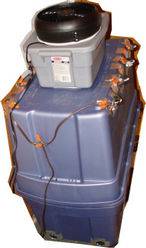G
Guest
Mariman-
Yes, I start the seedlings in perlite. One of the advantages of perlite is that it wicks moisture well.
I use a cup that is about 5" tall. I punch several holes in the bottom of the cup and set the cup in a shallow container. Wet the perlite and let the excess water flow into the container. Loosen the top of the perlite so it isn't packed tight, then set the seed in place and cover with about 1/8" to 1/4" of perlite; mist to moisten this top layer. If it's a strain I know has a hard-to-crack shell, I use a bit of vermiculite around the seed to hold extra moisture. Cover the cup with a piece of plastic wrap to retain moisture until the seed sprouts. Keep about 1/4" to 1/2" of water in the container; the perlite will soak it up as it needs it.
When the seed sprouts, remove the plastic wrap and put it under a weak light. The seedling should have enough nutrient to get it to the first set of leaves, then I use a weak hydroponic fertilizer solution to water it. I usually alternate plain pH adjusted water with the weak fertilizer to avoid burning the seedling. Put the water and fertilizer in the container, not over the top of the seedling; this encourages the seedling to dig deep with its roots to get to the larger amount of moisture at the bottom of the cup. Since the perlite will wick water for about 8", it won't be short of water in the cup.
When the seedling is about a week to 1-1/2 weeks old, I remove it from the cup gently, rinse the perlite out of the roots with lukewarm water, and put it into a cloning-size bubbler with a nutrient solution of about 300 ppm. I greadually increase the strength of the nutrient solution as the seedling grows and transfer it to a full size hydroponic unit (bubbler or ebb & flow) when it outgrows the cloner-size bubber.
The collars are about 3/4" long pieces I cut off of a tube of foam pipe insulation. Home Depot and Lowes both sell 6' lengths of it for about $1. I use the 1/2" size for the small seedlings & clones; it also comes in a size for 3/4" pipe which I use for the larger bubbler. Don't buy the foam that has the adhesive strips on it - get the plain stuff.
Yes, I start the seedlings in perlite. One of the advantages of perlite is that it wicks moisture well.
I use a cup that is about 5" tall. I punch several holes in the bottom of the cup and set the cup in a shallow container. Wet the perlite and let the excess water flow into the container. Loosen the top of the perlite so it isn't packed tight, then set the seed in place and cover with about 1/8" to 1/4" of perlite; mist to moisten this top layer. If it's a strain I know has a hard-to-crack shell, I use a bit of vermiculite around the seed to hold extra moisture. Cover the cup with a piece of plastic wrap to retain moisture until the seed sprouts. Keep about 1/4" to 1/2" of water in the container; the perlite will soak it up as it needs it.
When the seed sprouts, remove the plastic wrap and put it under a weak light. The seedling should have enough nutrient to get it to the first set of leaves, then I use a weak hydroponic fertilizer solution to water it. I usually alternate plain pH adjusted water with the weak fertilizer to avoid burning the seedling. Put the water and fertilizer in the container, not over the top of the seedling; this encourages the seedling to dig deep with its roots to get to the larger amount of moisture at the bottom of the cup. Since the perlite will wick water for about 8", it won't be short of water in the cup.
When the seedling is about a week to 1-1/2 weeks old, I remove it from the cup gently, rinse the perlite out of the roots with lukewarm water, and put it into a cloning-size bubbler with a nutrient solution of about 300 ppm. I greadually increase the strength of the nutrient solution as the seedling grows and transfer it to a full size hydroponic unit (bubbler or ebb & flow) when it outgrows the cloner-size bubber.
The collars are about 3/4" long pieces I cut off of a tube of foam pipe insulation. Home Depot and Lowes both sell 6' lengths of it for about $1. I use the 1/2" size for the small seedlings & clones; it also comes in a size for 3/4" pipe which I use for the larger bubbler. Don't buy the foam that has the adhesive strips on it - get the plain stuff.
Last edited:

 Hey Ambre! Found yer thread!
Hey Ambre! Found yer thread! 










